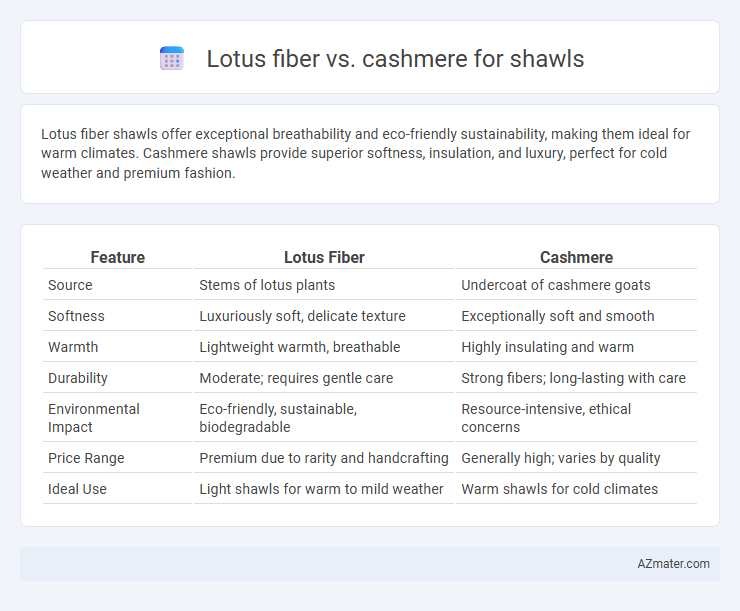Lotus fiber shawls offer exceptional breathability and eco-friendly sustainability, making them ideal for warm climates. Cashmere shawls provide superior softness, insulation, and luxury, perfect for cold weather and premium fashion.
Table of Comparison
| Feature | Lotus Fiber | Cashmere |
|---|---|---|
| Source | Stems of lotus plants | Undercoat of cashmere goats |
| Softness | Luxuriously soft, delicate texture | Exceptionally soft and smooth |
| Warmth | Lightweight warmth, breathable | Highly insulating and warm |
| Durability | Moderate; requires gentle care | Strong fibers; long-lasting with care |
| Environmental Impact | Eco-friendly, sustainable, biodegradable | Resource-intensive, ethical concerns |
| Price Range | Premium due to rarity and handcrafting | Generally high; varies by quality |
| Ideal Use | Light shawls for warm to mild weather | Warm shawls for cold climates |
Introduction to Lotus Fiber and Cashmere Shawls
Lotus fiber shawls are crafted from the rare, biodegradable fibers extracted from lotus stems, known for their lightweight, breathable texture, and natural hypoallergenic properties. Cashmere shawls originate from the soft undercoat of Cashmere goats, prized for exceptional warmth, luxurious softness, and insulating capabilities. Both lotus fiber and cashmere offer unique qualities, with lotus fiber emphasizing eco-friendliness and moisture-wicking comfort, while cashmere is renowned for premium warmth and a plush feel.
Origin and History of Lotus Fiber and Cashmere
Lotus fiber, derived from the fibers of the lotus plant's stems, originates primarily in Myanmar and Thailand, where it has been used for centuries in traditional textile production, especially in creating unique, lightweight shawls valued for their rarity and eco-friendly cultivation. Cashmere, sourced from the undercoat of the Cashmere goat native to the Himalayan regions of Mongolia, China, and Nepal, has a long history dating back over 2,000 years, prized for its softness, warmth, and luxury in shawls and winter garments. The distinct historical and geographical origins of lotus fiber and cashmere contribute to their unique qualities and cultural significance in textile craftsmanship.
Extraction and Production Process Comparison
Lotus fiber is derived from the stems of lotus plants through a labor-intensive process involving soaking, scraping, and hand-spinning, which yields a lightweight and breathable material ideal for shawls. In contrast, cashmere is sourced from the undercoat of Cashmere goats, requiring meticulous combing or shearing during molting season, followed by fine spinning to produce its renowned softness and warmth. The extraction of lotus fiber is more sustainable and eco-friendly but less scalable, while cashmere production demands careful animal husbandry and often involves a higher environmental footprint.
Texture, Softness, and Feel
Lotus fiber shawls boast a unique texture that is naturally crisp yet lightweight, offering remarkable breathability and a subtle sheen, perfect for warm climates. Cashmere shawls, made from fine goat undercoat fibers, provide unparalleled softness and a luxurious, warm feel that drapes smoothly against the skin. While lotus fiber feels slightly firmer and more structured, cashmere excels in plushness and warmth, making each suitable for different preferences in comfort and tactile experience.
Durability and Longevity
Lotus fiber shawls exhibit exceptional durability due to the strong, natural cellulose fibers derived from lotus stems, making them highly resistant to wear and tear over time. Cashmere, while renowned for its softness and warmth, is more delicate and prone to pilling and thinning with frequent use. Choosing lotus fiber ensures a shawl that maintains its structural integrity and appearance for a longer period compared to cashmere.
Sustainability and Environmental Impact
Lotus fiber offers exceptional sustainability due to its biodegradable nature and minimal water consumption during cultivation, making it an eco-friendly alternative to traditional fibers. In contrast, cashmere production often involves overgrazing by goats, leading to soil degradation and desertification, significantly impacting fragile ecosystems. Choosing lotus fiber shawls promotes environmental conservation, supports sustainable agriculture, and reduces the carbon footprint compared to cashmere.
Price and Market Value
Lotus fiber shawls are priced significantly higher than cashmere due to the labor-intensive process of extracting fibers from lotus stems, making them a rare luxury item. Cashmere shawls offer a more affordable yet premium alternative with high market demand and established global recognition. The market value of lotus fiber shawls continues to grow as eco-friendly and exclusive products gain popularity among niche consumers.
Warmth, Breathability, and Comfort
Lotus fiber offers exceptional breathability and lightweight warmth, making it ideal for versatile shawls in both cool and warm climates. Cashmere provides superior insulation and softness, delivering unmatched comfort and luxurious warmth during colder seasons. Both fibers excel in comfort, but lotus fiber is preferred for moisture-wicking properties, while cashmere is prized for plush warmth.
Style, Colors, and Design Versatility
Lotus fiber shawls offer a unique matte finish with natural beige and cream hues, lending a subtle elegance ideal for minimalist and eco-conscious fashion. Cashmere shawls provide a luxe softness with a rich palette, including deep jewel tones and vibrant pastels, enhancing sophisticated and classic styles. Both materials allow diverse design versatility, but cashmere supports intricate patterns and embroidery better due to its finer weave, while lotus fiber lends itself to textured, earthy styles.
Choosing the Best: Lotus Fiber vs Cashmere Shawl
Lotus fiber shawls offer exceptional breathability and natural moisture-wicking properties, making them ideal for warm climates, while cashmere shawls provide unmatched softness and superior insulation for colder weather. The sustainability of lotus fiber, derived from lotus stems, appeals to eco-conscious consumers, whereas cashmere, sourced from the undercoat of cashmere goats, is prized for its luxurious texture and warmth. Choosing between lotus fiber and cashmere shawls depends on climate preference, environmental impact, and desired tactile experience.

Infographic: Lotus fiber vs Cashmere for Shawl
 azmater.com
azmater.com